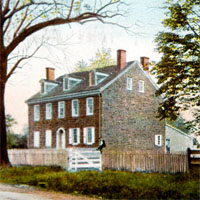The Strange Experiments of A. Frederick Collins
From 1899 to 1902, Narberth was the home and testing ground of Frederick Collins, where he attempted to invent the world's first wireless telephone. In one experiment that seems at home in Frankenstein, Collins used a “fresh human brain” to try to detect radio waves.
As the twentieth century approached, the miracles of the telephone and wireless telegraph fired the imagination of the public and the ambition of inventors. One of the best known among those who sought to achieve voice communication via wireless transmission was Archie Frederick Collins (1869-1952). Collins was born in Indiana, studied in Chicago and moved to Philadelphia in 1899 to join the American Wireless Telephone and Telegraph Company. But after a falling out, he left the company and moved to Narberth to work on his own.

World’s first wireless phone call in Narberth
"In 1899 Mr. A. Frederick Collins made the first successful experiment with wireless telephony at Narberth, Pennsylvania, when he succeeded in transmitting the human voice to a distance of three blocks of buildings." In a 1902 letter to Scientific American, Collins wrote "…tests, from the incipiency of the idea of wireless telephony, have been made at Narberth, Pa., where the conditions were all that could be desired." Photographs of the tests show Collins and his team in the field in a wooded, undeveloped Narberth. He lived and worked in the vicinity of present-day St. Margaret's School, which we surmise because "Dr. Rotzell, lecturer on zoology and anthropology of the Hahnemann Medical College, of Philadelphia, …resides near me in Narberth". Rotzell's house on the 1900 map aligns with the modern address 231 N. Narberth Avenue.

“A fresh human brain”
Collins performed a series of experiments in Narberth in September 1901 that could have inspired scenes in the 1931 movie Frankenstein. He was assisted by Rotzell and "Mr. Warner, a third-year medical student", 21-year-old Carden F. Warner of 214 N. Essex, the author in 1905 of Narberth's Historical Prelude. Attempting to better understand the effects of electricity, he used the brain of a "freshly killed mammal", then of a cat, and ultimately "a magnificent specimen of a human brain [that] came into my possession immediately after its removal from the cranium, and within a few hours after the death of the physical body."
"Readers of delicate sensibilities are advised to refrain from looking."

In his own words,
When the storm was at its height I substituted a telephone receiver for the testing set, and through it and the medium of the brain came three sounds like the cooling of a piece of redhot metal quickly submerged in water. Lightning had struck a house a quarter of a mile away, down in the valley of Narberth, ripping the slate roofing from the cupola. In these tests I was favored with circumstances, which, with me, might never occur again, for the reason that a fresh human brain was necessary, and that an electrical storm should be in progress when all was in readiness was quite remarkable.
—Frederick Collins, "The Effect of Electric Waves on the Human Brain", Electrical World and Engineer, February 22, 1902, page 335
Fraud and prison
The theatrical photographs and lurid prose quoted above make it clear that Collins the entrepreneur was a charismatic and tireless self-promoter. Eventually the increasingly frantic search for publicity and funding betrayed him. Having departed the wholesome precincts of Narberth, in 1911 he was arrested for mail fraud. He was convicted and served a year in prison. Although he did no further electrical engineering work after his 1914 release, he authored over 100 books, among them Jack Heaton, Wireless Operator and The Boy Scientist. The Radio Amateur's Handbook (1922) continued in print in revised editions through 1983.
Before his conviction, Frederick Collins was one of the most influential and highly regarded engineers in his field. Who's Who in America of 1920-21 asserted he "discovered effect of electric waves on brain cells; invented the wireless telephone 1899". And he did it in Narberth.
References
T. C. Bridges, The Young Folks' Book of Inventions (Boston, Little, Brown, and Company, 1925) Return
Willett Enos Rotzell (1871-1913) was also an author, of Man: An Introduction to Anthropology (1905), still cited today, and the eight-page Birds of Narberth, Pa., and vicinity (1895). Return
Vivian J. Phillips, Early Radio Wave Detectors (1980) Return
Updated September 25, 2023.






